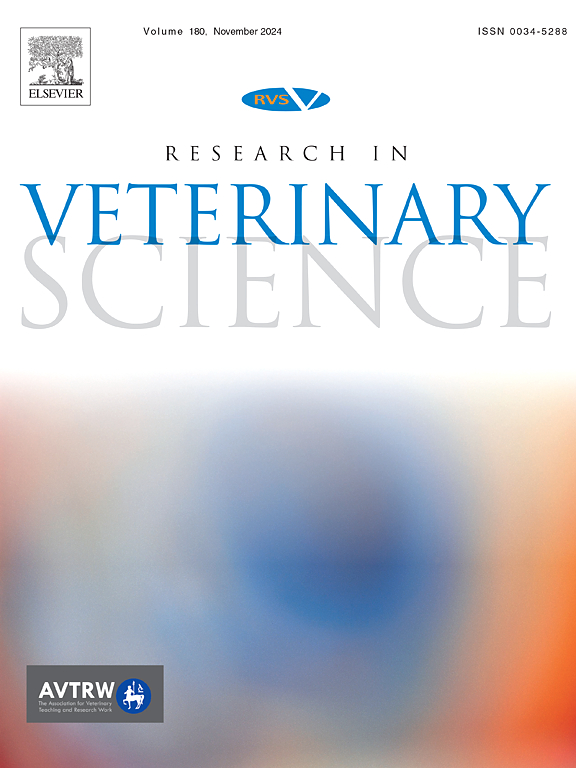新型羟基萘酚蓝重组酶扩增快速检测假中间葡萄球菌。
IF 2.2
3区 农林科学
Q1 VETERINARY SCIENCES
引用次数: 0
摘要
假中间葡萄球菌(S. pseudintermedius)是猫和狗的脓皮病、软组织、尿路和耳部感染的重要原因。细菌培养和生化表型分析是临床诊断细菌的金标准,但现在已经开发出分子方法来鉴定和区分假中间芽胞杆菌。然而,这些方法需要复杂和昂贵的设备,限制了许多实验室的使用。本研究建立了一种基于重组酶聚合酶扩增(RPA)结合羟基萘酚蓝(HNB)染料的假中间假葡萄球菌快速、特异、灵敏的检测方法。设计、优化RPA引物,扩增spsL基因作为分子诊断靶点。将HNB染料加入到该反应中,成功地建立了假中间芽孢杆菌的比色检测方法。RPA-HNB实验在37°C下20分钟内完成扩增,结果肉眼可见为颜色变化。所有程序都在一小时内完成。结果表明,每个反应的检出限为1个拷贝,对假中间葡萄球菌的敏感性和特异性分别为0.98和1.00。结果表明,该方法具有较高的检测灵敏度和特异性,且检测时间短。本文章由计算机程序翻译,如有差异,请以英文原文为准。

Novel hydroxy naphthol blue-based recombinase polymerase amplification for the rapid detection of Staphylococcus pseudintermedius
Staphylococcus pseudintermedius (S. pseudintermedius) is a significant cause of pyoderma, soft tissue, urinary tract, and ear infections in cats and dogs. Bacterial culture and biochemical phenotypic assays are the gold standards for clinical diagnosis of bacteria but molecular methods have now been developed to identify and differentiate S. pseudintermedius. However, these methods require complex and expensive equipment, restricting usage in many laboratories. This study developed a rapid, specific, and sensitive detection method for S. pseudintermedius based on recombinase polymerase amplification (RPA) combined with hydroxy naphthol blue (HNB) dye. The RPA primer was designed, optimized, and subjected to amplify the spsL gene as the molecular diagnostic target. HNB dye was added to the reaction, successfully enabling the development of a colorimetric detection method for S. pseudintermedius. This RPA-HNB assay completed amplification at 37 °C within 20 min, with results visualized by the naked eye as a color change. All processes were completed within an hour. The assay showed the limit of detection at 1 copy per reaction, with sensitivity and specificity against S. pseudintermedius 0.98 and 1.00, respectively. Results indicated that our assay provided high sensitivity and specificity for detecting S. pseudintermedius with reduced detection time.
求助全文
通过发布文献求助,成功后即可免费获取论文全文。
去求助
来源期刊

Research in veterinary science
农林科学-兽医学
CiteScore
4.40
自引率
4.20%
发文量
312
审稿时长
75 days
期刊介绍:
Research in Veterinary Science is an International multi-disciplinary journal publishing original articles, reviews and short communications of a high scientific and ethical standard in all aspects of veterinary and biomedical research.
The primary aim of the journal is to inform veterinary and biomedical scientists of significant advances in veterinary and related research through prompt publication and dissemination. Secondly, the journal aims to provide a general multi-disciplinary forum for discussion and debate of news and issues concerning veterinary science. Thirdly, to promote the dissemination of knowledge to a broader range of professions, globally.
High quality papers on all species of animals are considered, particularly those considered to be of high scientific importance and originality, and with interdisciplinary interest. The journal encourages papers providing results that have clear implications for understanding disease pathogenesis and for the development of control measures or treatments, as well as those dealing with a comparative biomedical approach, which represents a substantial improvement to animal and human health.
Studies without a robust scientific hypothesis or that are preliminary, or of weak originality, as well as negative results, are not appropriate for the journal. Furthermore, observational approaches, case studies or field reports lacking an advancement in general knowledge do not fall within the scope of the journal.
 求助内容:
求助内容: 应助结果提醒方式:
应助结果提醒方式:


